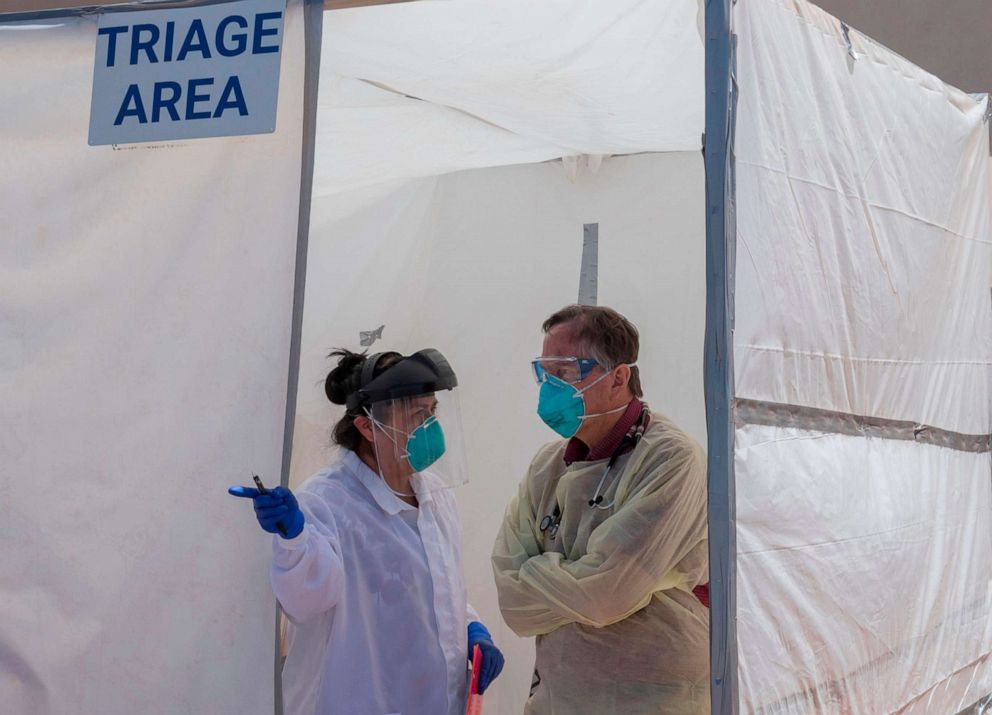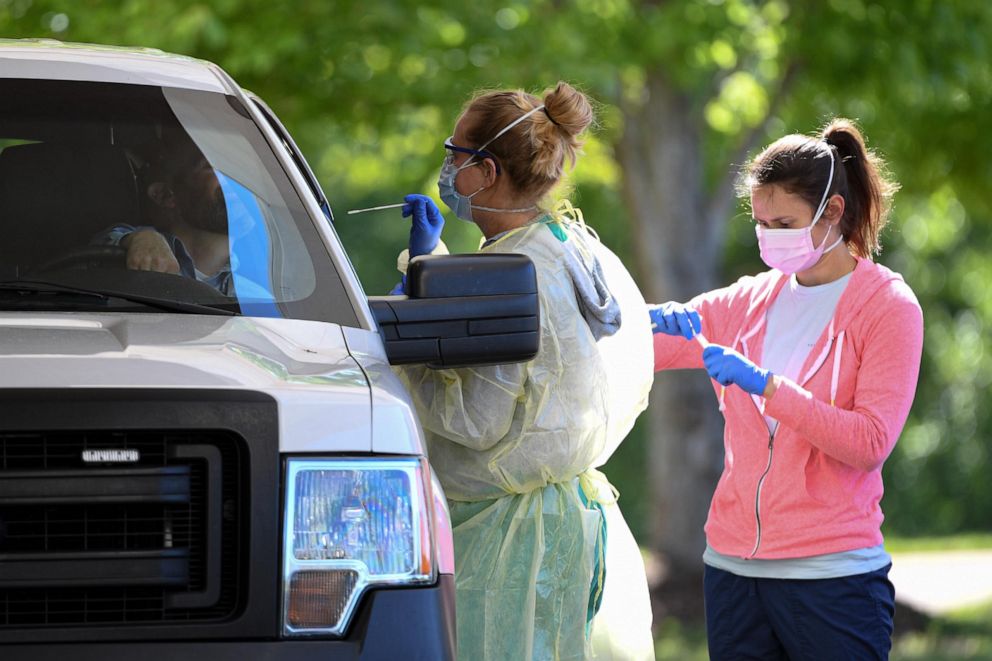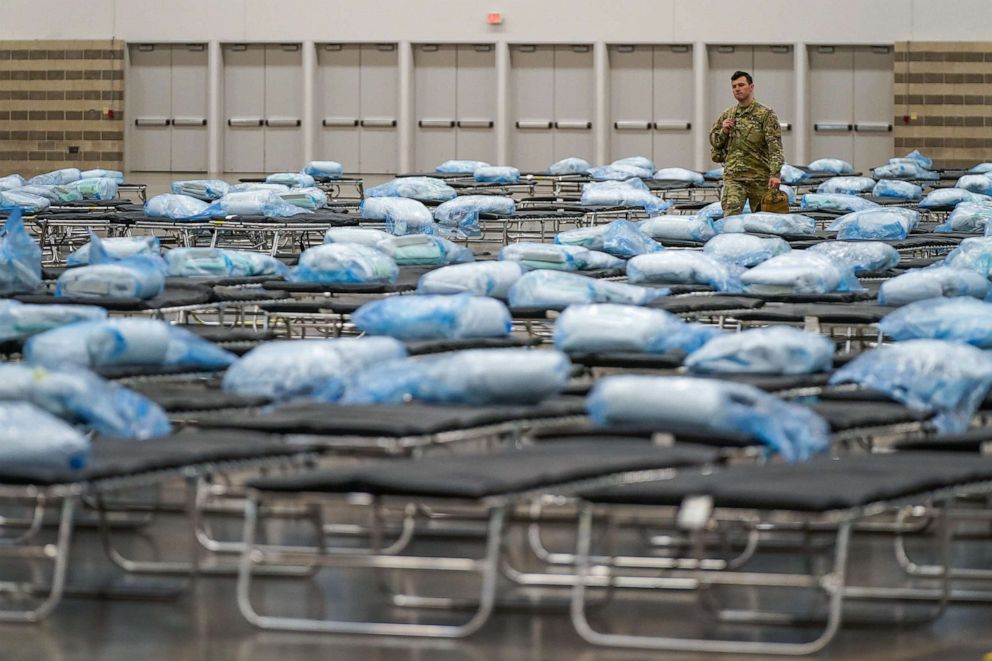In some states coronavirus hospitalizations on the rise, experts point to lack of social distancing
"I’m seeing these patients in my waiting room," doctor says.
Hospitalizations for the novel coronavirus are on the rise in at least eight states, in what experts and officials said was in part an expected consequence of states reopening their economies, but also made worse by some people who have begun to disregard social distancing guidelines and aren't appropriately wearing masks.
The states in which the hospitalization numbers are increasing are Arizona, Arkansas, Mississippi, North Carolina, South Carolina, Tennessee, Texas and Utah, according to a new analysis by ABC News of public data from the past two weeks.
In a few cases, the increases are stark, and hospitals are beginning to once again see signs of the surges that overwhelmed them during the height of the pandemic.
Arkansas, for instance, has experienced a 74% increase in average hospitalizations since after the Memorial Day weekend, and one official in the state told ABC News some hospitals there are "nervous." Arizona has seen a 49% increase in the same time frame, and an official there said hospitals are "definitely strained."
ABC News' analysis of state data compiled by the COVID Tracking Project, a volunteer project launched by The Atlantic, further showed that five states had mostly flat hospitalization rates, while the majority of states, 37, saw a downward trend.
Dr. John Brownstein, a Harvard Medical School professor, said there are "many reasons" why some states might see a rise in hospitalizations when others do not, but he singled out social distancing practices for potentially contributing to the increases.
"While reopening is happening everywhere, social distancing practices are highly variable," he said. "Memorial Day events looked quite different from state to state."
Brownstein, an ABC News contributor, said that "unfortunately," it's not surprising some states would see an increase in hospitalizations as people intermingle more and more.
"If places with active transmission open up too fast, our forecasts for mortality will, unfortunately, have to go up as well," he said.
Increases in the raw number of positive cases are also occurring in at least 21 states plus Puerto Rico, ABC News has previously reported, but many experts consider hospitalization rate to be a more accurate measure of disease spread, as new case counts can be artificially driven up by an increase in testing, creating a false perception of increase.
And while some states are seeing more significant increases in hospitalizations than others, public health officials or local experts in each of the eight states with increased hospitalizations told ABC News they consider the rises to be related to a reopening of the economy or a disregard of social distancing guidelines, including rejecting wearing masks.
Some top government officials have expressed concern that the ongoing nationwide protests could also contribute to the spread of the virus, but experts told ABC News it's too early to gauge whether that has been the case.
Dr. Anthony Fauci, the nation's top infectious disease expert, addressed some of the reopening concerns on Wednesday, urging states to recognize that "when you open, that doesn't mean that everything is okay."
"You still have to practice a degree of caution and carefully go through the process of trying to normalize. That means you still should be wearing a mask. You still should be trying as best as possible to have that physical distancing," Fauci told Robin Roberts on ABC's "Good Morning America" on Wednesday. "We know everyone wants to approach normality and get things back to normal including the economy, but that doesn't mean that all bets are off. And that's the reason why we say be careful and do it prudently."
But local experts say in many cases they are seeing the opposite. As states and cities continue to open up, social distancing norms followed during strict lockdowns are falling by the wayside. Dr. Brannon Traxler, the physician consultant for the South Carolina state health department, on Monday warned of the serious disregard for social distancing and masking in the state that is driving the spread of the disease.
"We are starting to notice a lot of people across South Carolina are not doing the social distancing or not avoiding group gatherings and wearing masks in public the way, especially, that they were earlier on," Traxler said.
And those states whose hospitalization numbers aren't necessarily increasing are keeping a close watch. California, for instance, has relatively stable hospitalization rates, while the number of infections continue to rise in some parts of the state.
"But more importantly, the numbers aren't really dropping," said Dr. Yvonne Maldonado, an epidemiologist and infectious disease specialist at Stanford Medicine. She said small upticks in hospitalizations "could possibly be related to opening up the economy. I mean, truly, we just started."
ABC News spoke to public health officials, local experts, and hospital representatives in each state to better understand each state's increase.

Arizona: 'We weren't ready to reopen'
Arizona has seen a 49% increase in hospitalizations in the state since May 26, according to ABC News’ analysis of state data collected by the COVID Tracking Project. Matthew G. Heinz, an internist at Tucson Medical Center, attributed the increase directly to a premature reopening.
"We weren’t ready to reopen. We hadn't met the criteria set down by the WHO [World Health Organization] or the CDC [Centers for Disease Control and Prevention] to even begin to look at reopening the state, but political leadership pushed us in that direction," Heinz told ABC News.
On the ground, Heinz said he could clearly see the increase manifesting.
"Starting June 3, I was admitting three, then four, then five cases per day and it’s just gone up since then. One thing is to see the numbers on a graph, but I’m seeing these patients in my waiting room," Heinz said. "After the loosening of some restrictions, we are now seeing a surge in hospitalizations, a surge in ICU usage and of course, unfortunately, a surge in the death rate."
Heinz also noted a worrying trend: rideshare drivers getting sick. “I had a 26-year-olds with COVID, who is an Uber and Lyft driver. He’s picking up and driving around 25 to 35 people per day and so it’s not surprising he got infected," Heinz said. "And he’s not the only ride-sharing driver I’ve seen.”
Ann-Marie Alameddin, CEO of the Arizona Hospital and Healthcare Association, also said she noticed the increase and said hospitals are "definitely strained" in metropolitan areas.
Arizona Gov. Doug Ducey acknowledged the increase in cases in the state, but said denied the state had reopened too soon.
"What we wanted to do was be prepared for this," he said at a press conference last week. "Arizona is prepared."
Arkansas: Some hospitals getting 'nervous'
On May 25, there were a little over 80 hospitalizations in Arkansas, but as of June 7, there are 173 people hospitalized.
Jodiane Tritt, Executive Vice President of the Arkansas Hospital Association, said some hospitals are starting to get "nervous."
“So we are starting to see some hospitals being nervous about capacity, but we feel pretty confident that the collegiality and the collaboration among the hospitals around the state can meet the demands of patients.”
North Carolina: 20% hospitalization increase in 2 weeks
North Carolina has seen a more than 20% increase in hospitalizations in the state since May 26, according to ABC News’ analysis -- an increase that appears to coincides with the state's Phase 1 and Phase 2 opening.
Cynthia Charles, a spokesperson for the North Carolina Hospital Association, which represents 135 hospitals and healthcare systems, said its members "feel the increase in hospitalizations coincides with North Carolina reopening for business."
"We initially saw an increase after opening in Phase 1, now they are seeing another one that comes from Phase 2," Charles said. "They're also concerned about people not using face coverings. They think it would help if more people would do that."
North Carolina announced on Saturday that hospitalizations had exceeded 700 for the past five days, according to the state's health department.
In a statement on Tuesday, Duke Health said it's seeing a "steady increase" in hospitalizations and positive cases. Their own patients have nearly doubled since May 15.
“The increase in hospitalizations began 10 days after the state entered the first phase of relaxing restrictions on travel, business operations and mass gatherings," the statement said.
Kelly Haight, a spokesperson for the North Carolina Department of Health and Human Services, told ABC News, "These trends are concerning and [the health department] is taking them very seriously." She also acknowledged the increases are tied to the reopening.
"It takes about two weeks to see the impact of a change in policy or an outbreak from an event, because the incubation period of the virus is up to 14 days," Haight said. "This is important to note because about two weeks ago, on May 22, North Carolina moved to Phase 2."
South Carolina: More hospitalizations, but 'we have quite a bit of capacity'
South Carolina has experienced a 10% increase in hospitalizations, but it hit a new record high in the state on Monday. The state reported 507 hospitalizations, the highest number since previous total of 502 occupied beds on May 8, according to the state health department.
Dr. Brannon Traxler, the physician consultant for the South Carolina Department of Health and Environmental Control (SCDHEC), said the increase in hospitalizations correlated with the increase in overall cases -- ultimately, the virus is still spreading in the community, she said.
"There is disease continuing to spread, and increasing in that spread, especially compared to several weeks ago," she said.

Traxler also noted that people are not social distancing.
"We are starting to notice a lot of people across South Carolina are not doing the social distancing or not avoiding group gatherings and wearing masks in public the way, especially, that they were earlier on," she said.
Dr. Chris Carr, a Senior Clinical Advisor for the South Carolina Hospital Association, said she believes the increase in hospitalizations "reflects the opening of the economy."
Nick Davidson, the health department's incident commander for COVID-19, said that because they still have overall capacity to handle the increase, they are not yet concerned.
"Occupancy rates are still actually somewhat below that which we would expect during a non-pandemic time," Davidson said. "The capacities we're seeing that are in the 60 to 70% range, even though that's a bit higher than it was, say, a month ago in the 50s to 60s, typical bed occupancy rates around this day are in the, you know, a five percentile range.
"So, we're still actually, we have quite a bit of capacity so we feel good," he said.
Utah: Seeing a 'statewide spike'
Utah has experienced a 17% increase in hospitalizations in the past two weeks. Charla Haley, a spokesperson for the Utah Department of Health, called it "statewide spike."
"There are only a small handful of counties in Utah that haven't seen growth and we are looking at a statewide spike," Haley said. She added there "isn't a single reason" for the increase, but the reopening contributed.
"As restrictions were loosened, we expected to see an increase in cases and are reinforcing our prevention messages of wearing masks when in public, social distance when possible, limit large gatherings, and stay home when you're sick," Hayley said.
Texas: Hospitalization rates increase, but slower than new positive cases
There has been an increase in the number of new cases in Texas in the past couple weeks, data released by the state’s health department show, while hospitalizations have grown at a slower rate. Hospitalization statewide increased by 10% in the last two weeks.
Hospitals in the greater Houston area reported a 3.5% average growth in the daily hospitalization trend and a 1.9% growth in the daily COVID ICU occupancy trend in the past week, according to data collected by the Texas Medical Center (TMC). And the average of daily new cases at those hospitals increased 57% from last week.
The occupancy rates for ICU beds at Houston-area hospitals also currently stands at 71%, according to TMC's data, and TMC on Monday projected that if the upward trend continues, the ICU capacity could be exceeded in two weeks. On Tuesday, the center took down the warning a notch saying that the ICU capacity could be exceeded in five weeks.
This upward trend emerged a little less than three weeks into Phase 1 of the reopening on May 1, and accelerated in late May and early June following the Memorial Day weekend. Before, hospitalization was on a gradual decline.
CEO of Houston Methodist Dr. Marc Boom told ABC News there is "no question the trend line is going up."
A spokesperson for the Texas governor's office, however, pointed to some other figures for reassurance.
“Since Texas opened on May 1, testing has increased by 210 percent, the doubling time has gone from 20 days to 36 days, and the state continues to have one of the lowest death rates in the nation. Every Texan who needs access to a hospital bed will have access to a hospital bed," Gov. Greg Abbott's Communications Director John Wittman told ABC News. "Current hospital capacity includes 15,402 available beds, 1,723 ICU beds and 5,911 ventilators, with the ability to surge capacity in regions across the state if necessary.”

Dr. James McDeavitt, senior vice president of clinical operations at Baylor College of Medicine, pointed out that while the growth rate is slower now than it was back in mid-April, the daily case rate and daily hospitalization rate is back up to the same level.
McDeavitt said that hospitalization is growing at a slower rate than positive cases because back in March and April, the state was only testing those that were already seeking hospitalization, not those with light or no symptoms.
Both McDeavitt and Boom said the growth in cases and hospitalization could somewhat be attributed to reopening as well as personal behavior and relaxing social distancing efforts.
Texas has seen large demonstrations related to the death of Houston-native George Floyd in Minneapolis, but McDeavitte and Boom said it’s too soon to see any effects of the mass protests in the past week. But they said they expect an increase in numbers in the coming days.
Mississippi: 'Biggest issue is becoming complacent with social distancing'
In Mississippi, the statewide hospitalization trend has increased by about 3.5% over the past couple weeks, daily state-released data shows.
Tim Moore, president and CEO of the Mississippi Hospital Association, told ABC News that hospitalization is growing at a higher rate -- about 5% to 8% -- in more highly populated areas, and said the hospitals are monitoring a surge cases and hospitalization regionally.
He said hospitals in the Jackson metro area and the Wayne County near the Alabama border are feeling strained with an influx of hospitalization, while hospitals in the rural Grenada County are bracing for an influx as the county sees a 23% increase in cases. He said Madison County has recently had an uptick in cases due to an outbreak in poultry plants, but +++[he said]+++that that's mostly been mitigated.
"Opening up could have had some impact," Moore said, "but the biggest issue is becoming complacent with social distancing."
Moore said while the public in general has been doing what they need to be doing, he's seen various large gatherings in the past few weeks, including graduation events and funerals, play a role in spreading the virus in the community.
"I know we had a situation in south Mississippi -- we had an elderly gentleman that was having a birthday party," Moore said. "You know, if they want to do that and the family wants to do that, and when you say you can't do that, everybody gets upset. So maybe you don't say you can't, but you don't need to do that."
Moore said he's also monitoring the recent opening up of recreational parks in the state.
"You always just have to have concern about this," Moore said. "We can't ignore it, but we have to re-approach life and learn to live with it until we learn to live around it, until we can come up with a vaccine."
Tennessee: Expected a slight rise
Tennessee reported a total of 1,974 cumulative hospitalized patients on June 9. The average daily increase of hospitalization in the state rose nearly 64% on average from two weeks ago.
A spokesperson for Tennessee Gov. Bill Lee’s COVID-19 Unified Command Team Dean Flener told ABC News in a statement Tuesday that the state "expected to see a slight rise in cases as more businesses reopened and more individuals left their homes more frequently."
"Thus far, the rise is manageable and the rates of transmission and positivity have been relatively stable with hospitalizations increasing gradually. We continue to watch the data closely to make the best decisions to maintain the health and well-being of Tennesseans," Flener said.
Vanderbilt University Medical Center spokesperson Craig Boerner also told ABC News on Tuesday that the hospital, which is the only Level One Trauma Center in Nashville, has not seen much of a difference in their patient count from two weeks ago.
Currently, the hospital has 22 patients they're treating with COVID-19. Eight of those patients are in the ICU, and five of those patients are on ventilators. "But the number [of COVID-19 patients in the hospital] last week and week before was more, at one point, up to 26," Boerner said.
It's unclear why Vanderbilt University Medical Center has not seen an uptick in patients, but according to a county-level analysis by the New York Times, Davidson County, where Nashville is, is among several counties where cases are on the rise, though some other counties, such as Lake County and Macon County are seeing a higher rate of increase.




